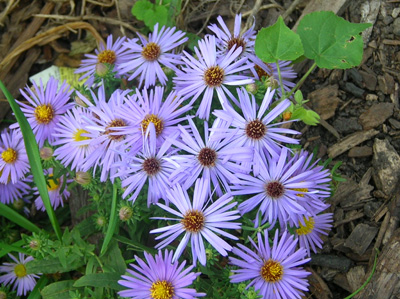
Gardener difficulty rating for genus: 2
yellow-thumb special - easy to grow in right condition
Habitat: Aromatic aster (A. oblongifolius ) is native to open dry areas and hillsides of North America east of the Rockies.

Hardiness: Its range extends from Zone 4 to 9.
Light: Full sun. Raydon’s Favorite aster will tolerate partial sun but grows best in the open.
Soil and pH: Well drained soil is essential. Average garden pH will do fine.
Moisture: Like most asters native to the short-grass prairie and other open areas, it requires little watering. If severely dry, supplemental watering will help.
Planting: They are normally sold as potted plants. It is sometimes hard to find them before Autumn, as most nurseries only display plants when they are in bloom. You may have to ask a worker to bring the plant to you in Spring or Summer. There are many mail order sources on the web.
Plant the crown at the surface in well-drained soil. Place in the full sun in an open area. Although not as susceptible to overcrowding diseases (like powdery mildew) as most asters, good air circulation is still encouraged. Plus, planting in the open allows for strong, stocky growth.
Pruning/Pinching: In garden settings most asters should be pinched to promote compact growth that doesn't need staking. Raydon’s Favorite aster is naturally compact, but pinching helps it too. My specimen and border plants are pruned in the beginning of May, June, and July. Pruning any later than early July may reduce the blooming period. So if it is not done by the 4th, forget about it. I follow the same guidelines for trimming my aster hedge, but I use clippers instead of pruners.

Pests and Diseases: Fragrant plants, like mints and onions, use aromatic compounds to protect themselves from herbivory by animals and insects. Perhaps the aromatic compounds in Raydon’s Favorite aster protect it as well. It is resistant to deer, rabbits, and rodents. However, hungry rabbits in my garden have eaten some of the green buds on the crown in Winter.
Although bees and butterflies regularly visit, I have never seen a caterpillar eating the leaves. The little leaves seem too tough and hairy.
Raydon’s Favorite aster even appears resistance to powdery mildew. Until I got rid of them in Autumn 2004, every year Joe-pye weed and bee balm would spread powdery mildew to my goldenrods and asters, especially A. novi-belgii “Milka”. But Raydon’s Favorite aster was never affected, even though it received regularly overhead watering from its proximity to the okra patch.
Propagation: Propagation is possible through division, stem cuttings, or seeding. Division is simple and sometimes necessary to control the size of a clump. Because my gardens are heavily planted with Spring ephemerals, I prefer to divide at the end of the season, when my digging will do less damage. Cut all the stems to about 2”. Dig up the clump and divide. Each division should have a few healthy stems. This is not delicate work. I use spades and shovels to cut through the tough roots. Don’t worry about the crackling and snapping sounds; this plant is a survivor.
Stem cuttings are also easy. Take your cuttings in Spring or early Summer, add rooting mix, and place in a moist vermiculite/sand mix. Make sure the mix does not dry out.
Seed can also be sown but the off spring may be variable. Aster seed can be sown directly in late autumn or stratified and then sown in spring.
